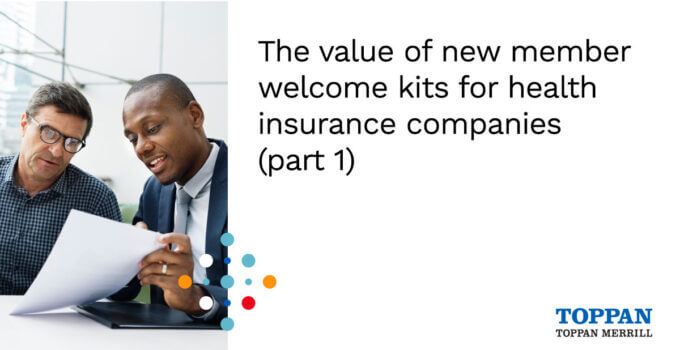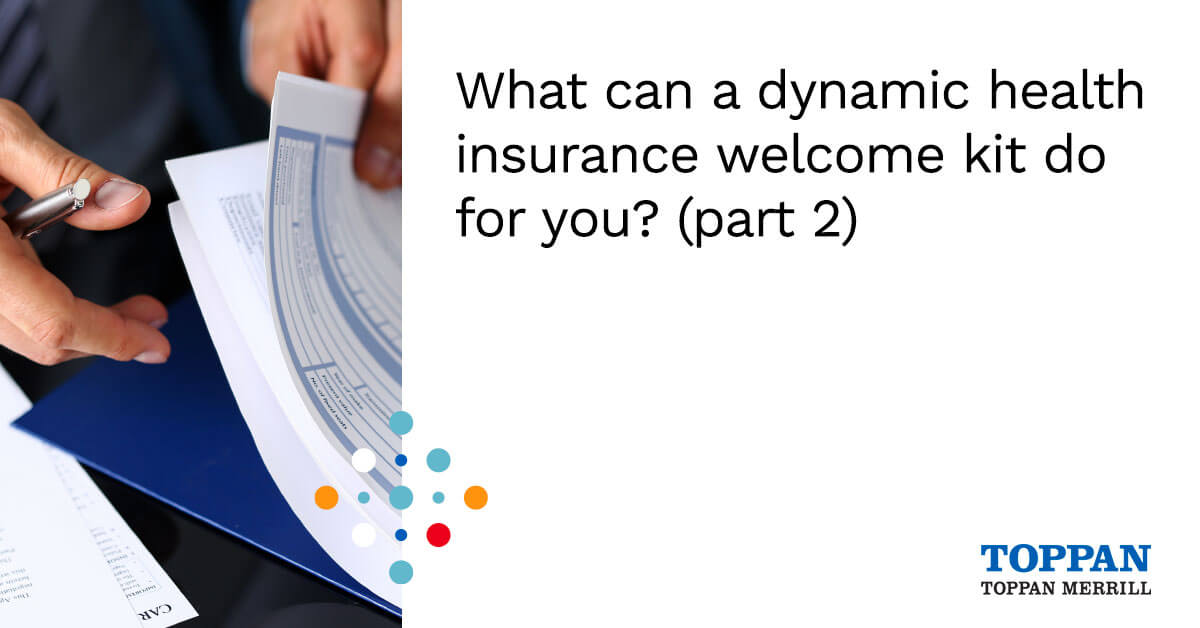Prioritize customer experience
Welcome kit materials should be driven by the member’s perspective from concept to final product. For government-sponsored plans specific standardized pieces may need to be included to meet regulatory requirements. Managing creativity while adhering to these requirements can sometimes be challenging, and you may need to shift your focus to nonrequired pieces and content packaging.
Consider the overall message you wish to convey to new members, and how it will be received by them. What’s the most important information they need to know? What do you want them to feel when they receive it? How can you meet them wherever they are on their healthcare journey?
A consumer focus group is an excellent resource for finding out what interests’ members and what type of messaging resonates with your intended audience. Remember, consumer populations include a range of individual goals, interests, and lifestyles. You may want to consider creating personas to represent different demographics within your member population and developing materials with these distinct personalities in mind.
Personas can help you break out of the mindset of viewing your audience as a homogenous group and instead as individuals with particular needs. Hone in on how your marketing materials might suit these needs with the following questions when creating personas:
- Who is this person? What is their age, occupation, and educational background? What type of home do they live in? Are they single, married, or in a relationship? Do they have children, and if so, what ages? The more specific you can be in creating unique and detailed personas, the more meaningful they become.
- What are each persona’s goals in interacting with their health plan? What do they hope to accomplish in the short term and in the long term? A person who is retired and living with a chronic health condition is going to look at health plan materials a lot differently than a recent college graduate who is new to having their own policy.
- What is their comfort level with technology? Is this someone who does their banking through their mobile device? Or is this someone who writes out and mails a physical check to pay their mortgage each month? These details can be especially useful in determining a distribution strategy, as well as opening channels for member engagement their welcome kits.
Give each persona a name. Maybe even assign a stock photo image, so you can picture them in their daily life. Being able to envision how “Marcus” or “Margaret” or “Max” might feel about their welcome kit can be a powerful exercise when creating your materials. It can also be helpful to leverage demographic data you already have about your member population, such as age or employment status, when determining what types of personas might represent of segments of your population.
Instead of creating a suite of materials that resonate with every persona, the idea is to ensure that each persona is considered and represented. By using personas, you can diversify your marketing materials and provide more personalized marketing materials that speak to individual interests.
Consider omnichannel distribution
Health insurance welcome kits are traditionally distributed as printed packets you either receive in the mail or are given to you during a work orientation, but now there are a vast range of digital communications channels. The trick is to find the right balance between digital communications and the traditional print medium to reach your members effectively and meaningfully.
Email, text messages, and mobile apps notifications are all commonplace, but that doesn’t mean everyone is comfortable or confident using them. Meanwhile, some members don’t want to be bothered with mailers and brochures, and much prefer a paperless approach. Others might like a mix of distribution channels, receiving some materials in the regular mail and others via electronic delivery.
Health insurers should consider leveraging different distribution channels to suit distinct member preferences. There are platforms available today that allow you to track how your members prefer to receive communications from their health plans. These solutions enable marketers to vary their preferred distribution channels seamlessly, without duplicating messaging or materials. This is important because duplicate messaging — getting the same communication via text message, email, and mailed letter —could eventually lead to the member dismissing communications.
Messaging management systems today are sophisticated enough to handle various levels of omnichannel distribution even on an individual level. Depending on your members’ preferences, it may make sense to send some information via mail and provide more details through email campaigns, your website or secure online member portal, or via other distribution channels.
Organize Information intuitively
Most new member welcome kits include a variation of the same type of materials, differing based on the needs and personas of the members. They generally include an overview of how the health plan works, including coverage basics, plan deductibles and cost-sharing, and other information on how to use the plan. Welcome kits may also include promotions for health and wellness programs, value-added discounts, and other perks. It can be easy to get too granular with information and overwhelm new members, which is why it’s important for health insurance companies to be mindful of how they put together their welcome kits.
Health plans need to be mindful of compliance requirements and confirm which types of inserts are necessary and permissible for inclusion with member materials. Certain combinations of inserts may be prohibited, depending on the plan type. Include your internal compliance team as reviewers, to ensure welcome kit materials satisfy industry guidelines. It’s crucial to work with a marketing team that not only brings an understanding of these parameters to the table but offers a creative approach to the design process.
Organize information in a way that makes sense and is intuitive to the member. Start with an introduction and overview that offers some guidance on what’s included in the welcome kit as well as how members should use it.
Save extraneous details for more in-depth sections and make sure they are easy for members to find. Even print pieces need to be simple to navigate so that members can quickly and easily find what they’re looking for without having to read every word. Be respectful of your member’s time and attention. Include a table of contents. Embed hyperlinks in digital pieces. Use clear headings and subheadings. Highlight the most important information in text boxes or with other visual cues. Introduce terminology not familiar to general audiences in a concise manner that isn’t condescending and doesn’t interrupt the flow of the text.
Keep in mind that a welcome kit is an introduction. While it’s good to be comprehensive, a welcome kit doesn’t need to be a complete reference. You can direct members to additional resources, such as your member website or network provider directory, that might be useful for those who want information beyond what’s included in the welcome kit.
Set the tone
People often think of health insurance companies as being stiff and bureaucratic. A friendly, conversational tone can go a long way in conveying warmth and helpfulness. Health plan marketers shouldn’t overwhelm members with more information than they need or clutter the material with industry jargon. Put yourself in their shoes by anticipating questions and clarifying terms that may be unfamiliar to them.
Content should be written similarly to how people speak to one another in casual conversations. Keep sentences short and straightforward. Use contractions. Employ transitional words and phrases frequently. Opt for shorter words, like “use” instead of “utilize,” for example.
Be intentional with conveying sentences positively. You may be required to use specific language when talking about certain concepts for government-sponsored plans. Look for opportunities to relay the advantages of a plan’s policies or to offer tips on how members can get the most value from their plans. Even small nuances can help set an overall positive tone, which is essential in crafting constructive communications and creating a meaningful relationship with a new member.
Health plans have a lot of ground to cover with new member welcome kits, including:
- Offering an overview of benefits details
- Educating members about providers in the network
- Helping members understand pharmacy benefits
- Informing members about health programs available
That means a lot of opportunities to leverage clear and supportive language to help build trust with your new members. Every point of engagement with members is an opportunity to build trust, and new member welcome kits are a great start.
Members who are actively engaged in their healthcare may be more likely to stay on top of preventive care and recommended screenings. This type of strong customer engagement can translate to better health outcomes and lower costs of care – a win for both the consumer and the health insurance company.
How Toppan Merrill can help
Toppan Merrill offers several services, including document creation and management, sales enablement, omnichannel communications, printing services, and more. We deliver best-in-class solutions that help you respond quickly to changes in regulations, client needs and markets.
Learn more about how we can help you with mission-critical content by visiting our website.

